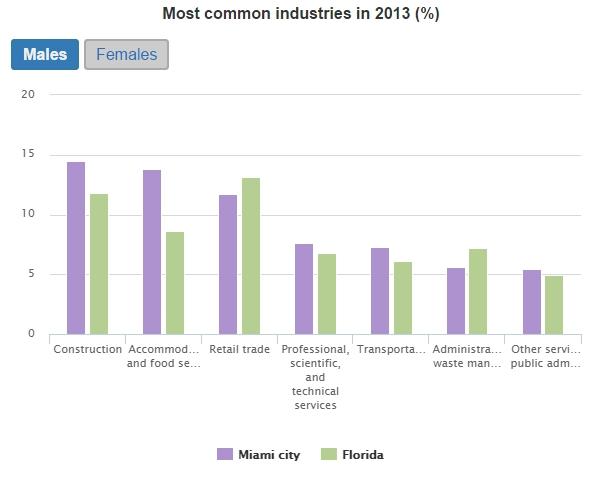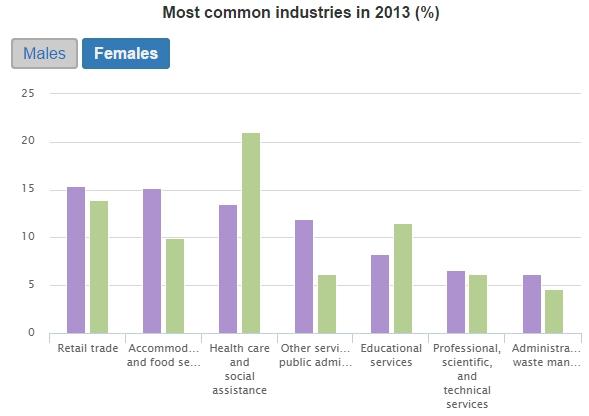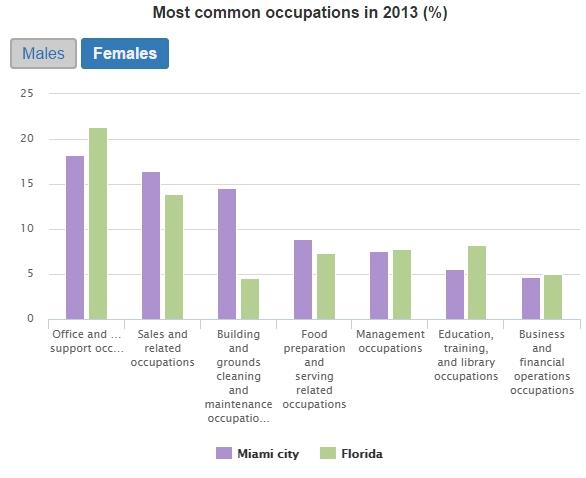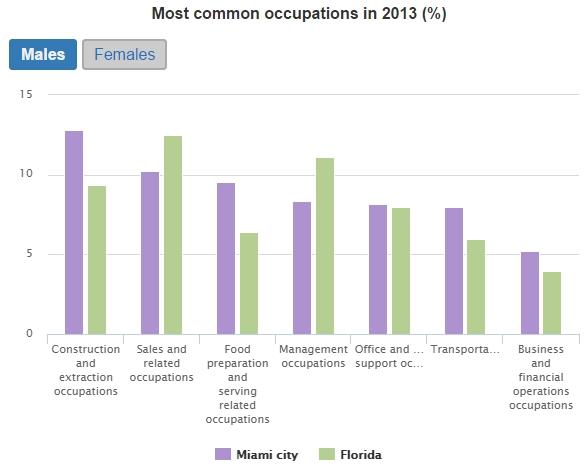Overview
Description of the Community
History
The city of Miami was founded in 1870; previously, this area was inhabited by the Tequesta Indians who, however, were almost completely exterminated by Spanish and British missions. At the end of the 19th century, Florida’s railroad was extended so that it could reach the city; the Miami Harbor was established as well (Miami, Florida, 2016). In the 20th century, the city became a recreational area, and in the 1960s, the city’s population boosted due to Cuban refugees (Miami, Florida, 2016).
Type of community
The Miami community is 100% urban (Miami, Florida, 2016).
Physical Environmental Considerations: The Community as a Place
Description: General Identifying Data
Location
The city is located in the U.S. state of Florida on its Atlantic coast in the region of tropical wetlands, also known as the Everglades. The city is partially surrounded by Biscayne Bay (Miami, Florida, 2016).
Topographical features
The city’s total area is 55.27 sq mi (Miami, Florida, 2016). The city consists of hundreds of artificial and natural islands that lie on the shores of the Biscayne Bay. Its elevation above the sea level is approximately twelve feet (Miami, Florida, 2016).
Climate
The climate can be described as semi-tropical; the summer in Miami is long, and the winter is mild and with regular rainfalls (Miami, Florida, 2016). Average temperatures are 83.5° F in July and 68° F in January (Miami, Florida, 2016).
Boundaries, Area in Square Miles
The total area of the city is 55.27 sq mi, but only 35.67 sq mi is land (Miami, Florida, 2016). Approximately 19.60 sq mi is water (Miami, Florida, 2016).
Environment
Biscayne Aquifer and Lake Okeechobee are the main water suppliers of the city. The sewage system is extended throughout the city, but it needs urgent repair and rebuilding in order to cover all zones in the city (Miami, Florida, 2016). The city of Miami, as well as commercial organizations, provide garbage collection services to the citizens.
Pollutants and toxic substances can be found in soil and water, leading to lead poisoning in children. The city provides a wide range of animal services. Miami consists of seven floral zones, including savannas, pinelands, and Flatwoods (Miami, Florida, 2016). Alligators and crocodiles, manatees, dolphins, and killer whales are common representatives of Miami’s fauna.
Air PM10 pollution level in Miami is low (Miami, Florida, 2016). Nevertheless, long-term exposure might trigger health risk due to the greater presence of particulate matters in the air.
The Florida Department of Health provides “Food Manager Certifications” for those who are linked to the storage and service of foods. A certification examination is obligatory for a food manager to pass (What is a food manager?, 2015).
As the potential disasters in the population, The Florida Department of Health names terrorist attacks and natural disasters. Rising sea levels and hurricanes present danger to the population too.
The Florida Department of Health provides a detailed overview of preparedness tools and partners, reports, resources, and hospital contracts that aim to ensure the safety of the population during an emergency.
Housing
Three-quarters of the public housing of the Miami-Dade Country is located in the City of Miami. Multi-family units are built more often than single-family units due to their need. Condition of housing depends on the city zone where it is located: while city zones where members of the upper and middle class live correspond with all housing standards, housing units of low-wage workers or unemployed individuals can be damaged, have pests, holes in the walls and the floor, etc. (Miami, Florida, 2016). In 2014, 40.45% of the Miami population was renters (Miami, Florida, 2016).
Special populations in Miami include senior citizens, HIV/AIDS persons, and people with disabilities. HIV/AIDS persons prefer to live alone, but they have to spend a significant part of their income on rent; persons with disabilities experience the same problem. Elderly citizens struggle with the high cost of rent (Miami, Florida, 2016).
Leading Industries and Occupations
The leading industries and occupations among female and male citizens are represented in the following figures (see Fig. 1, 2, 3, 4):




The People of the Community
Population Profile
The total population of Metropolitan City is approximately 441,120 (Miami, Florida, 2016). The total population of the urban area is 5,502,441. Population density is 12,063 people per square mile; the population continues to grow: in 2010, 399,457 people lived in the Metropolitan City (Miami, Florida, 2016). The mobility of the population is not high: 11.5% moved since the previous year; 88% of the population lives in the same house as in the previous year (Miami, Florida, 2016). There are approx. 157.470 nonfamily households, 188,000 households with children, and 342,540 households without children (Miami, Florida, 2016).
Biological Considerations
The median resident age in Miami is 38.9 years; 51% is male, 49% is female (Miami, Florida, 2016). 71.1% of Miami is Hispanic, 17.8% is Black, 9.9% is White, and 0.7% is Asian. Ethnic groups in Miami include Cubans, Mexicans, Puerto Ricans, Haitians, and African Americans, as well as others.
Birth rate per 1,000 in 2015 was 12.2, while the death rate was 590.3; the infant mortality rate is 4,8%, and maternal mortality rate per 1,000 is 10 (Florida charts, 2015). Leading causes of death are heart conditions and cancer (Florida charts, 2015). Cancer incidence rate is 404.4 per 100,000, but there is no recent data about cancer prevalence in Miami.
Psychological Considerations
Historical events that occur in Miami can be linked to hurricanes and other catastrophes, as well as occasional demographical shifts. Future economic prospects of Miami are bright, but the poverty level is rising due to the increased cost of rent, foods, transportation, and services. International trade in Miami can provide new jobs, but housing affordability issue needs to be resolved to improve the economic prospects for all citizens. The formal and informal communication networks are present and include centralized and decentralized networks. Teen death rates show that firearms are the leading causes of death in homicide and suicide (88% vs. 30%) (Florida charts, 2015). Protective services in Miami are widespread and include both adult and children protective services, which adequacy is undisputable. Common sources of stress are unemployment, poverty (among low-wage workers), and health conditions.
Sociocultural Considerations: The Community as a Social System
Socioeconomic status
Estimated household income in Miami is $31,070 as of 2013 (Miami, Florida, 2016). The level of unemployment is 9.3%. In 2013, 36.5% of the residents had an income below the poverty level. More than 20% of the population is retired (Miami, Florida, 2016).
Educational level
60% of the population is not religious, 21.8% is Catholic, and 10.9% is Evangelical Protestant. 40.2% has never married, 36.2% is now married, 4.4% is separated, and 13.1% is divorced (Miami, Florida, 2016). 60% of population mark Spanish as the language spoken at home (Miami, Florida, 2016).
Government and Leadership
The government of the city is under the City Charter; the form of the government is mayor-commissioner. Miami City Hall is located on Dinner Key in the former Pan American Terminal Building; the business hours are 8 AM – 5 PM.
Education
There are 206 elementary schools, 55 junior and middle schools, 38 senior schools in Miami. The largest public university is the Florida International University. The Miami-Dade Public Library System includes 34 branches, as well as four regional libraries (Miami, Florida, 2016).
Services provided by the city help pregnant teens, adults and children with disabilities, children who are deaf or blind: Cope Center North, Housing for Pregnant Homeless Women, Covenant House, APD, Parent to Parent, etc.
Transportation
Transportation facilities include the Miami International Airport, the Port of Miami, Amtrak (rail service), Metrorail-Metrobus system, and the Metromover (Miami, Florida, 2016).
Behavioral Considerations
As of 2016, 36% of the expenditures is housing, 18.1% is transportation, 13.7% is food, 10.5% is insurance, 6.0% is healthcare. The nutrition level of the population is higher than average; the frequency of obesity implies the citizens need to be more attentive to their eating habits.
Health System Considerations
Health services in Miami include student health service, catholic health service, Florida Department of Health, behavioral health services, and others. The current levels of performance are satisfactory (Miami, Florida, 2016). Particular health services are not available to people with disabilities or do not provide sufficient access for these persons. More than 40% of the population lacks health insurance (South Miami hospital, 2013). Chronic disease management remains unsatisfactory in some zones of the city (South Miami hospital, 2013). Primary and preventive care are overused, while health care services that manage obesity and addictions are underused. Healthcare GDP per capita in Florida was $3.452 is 2013; therefore, healthcare is an important force in Florida’s economy (South Miami hospital, 2013).
References
Florida charts. (2015). Web.
Miami, Florida. (2016). Web.
South Miami hospital. (2013). Community health needs assessment. Web.
What is a food manager? (2015). Web.